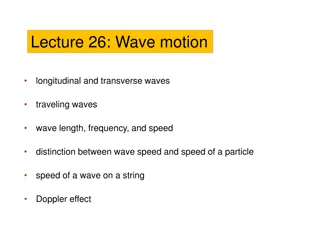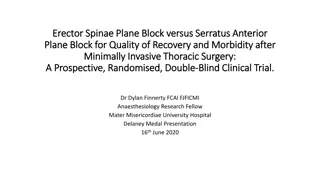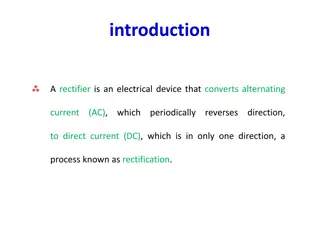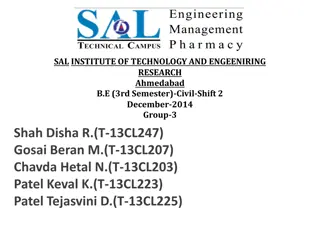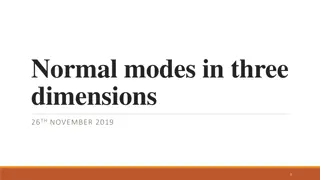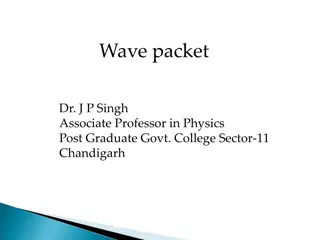Understanding EM Plane-Wave Transformation Notes
In these notes by Prof. David R. Jackson for ECE 6341, the concept of EM plane-wave transformation is discussed in detail. It covers topics such as the relationship between Er and Ar, Hr and Fr, field components representation, integration formulas, and notation usage like Harrington notation. The content emphasizes working with radial components Er and Hr for a clearer understanding of electromagnetic plane waves.
Uploaded on Oct 10, 2024 | 0 Views
Download Presentation

Please find below an Image/Link to download the presentation.
The content on the website is provided AS IS for your information and personal use only. It may not be sold, licensed, or shared on other websites without obtaining consent from the author. Download presentation by click this link. If you encounter any issues during the download, it is possible that the publisher has removed the file from their server.
E N D
Presentation Transcript
ECE 6341 Spring 2016 Prof. David R. Jackson ECE Dept. Notes 26 1
EM Plane-Wave Transformation z i x E e = jkz E 0 a y ( ) ( ) i = x E cos E n n a j kr P 0 n = 0 n x = + n ( ) (2 1) n a j n i E Note: The incident field will be represented using both Ar and Fr. 2
EM Plane-Wave Transformation Er directly corresponds to Ar Hrdirectly corresponds to Fr 2 i r 1 A r = + 2 i r i r E k A 2 j 2 i 1 F r = + 2 i r i H k F r r 2 j Any other field component will involve both ArandFr (please see the next slide). So, it is nice to work with these two radial components (Er and Hr). 3
EM Plane-Wave Transformation (cont.) = = rA rF 2 1 r E = 0 = + 2 r E k 2 j r 1 2 1 = E = E sin r r r j 1 2 1 r = = E E sin j r r 2 1 H = = + 0 2 H k r r 2 j r 1 sin = H 2 1 = H r 1 r r j 1 r 2 = = H H sin j r r 4
EM Plane-Wave Transformation (cont.) ( ) ( ) = x r = sin cos i r i x i x E E E n ( ) ( ) = sin cos i r cos E E n n a j kr P 0 n = 0 Not in the form of a Debye spherical-wave expansion! We need to put this in a form so that is matches with what we get from the Debye potential representation. 5
EM Plane-Wave Transformation (cont.) Try this: = sin cos cos i r jkr E E e 0 1 jkr ( ) = cos jkr cos E e 0 E jkr = cos ( ) (cos ) 0 n n a j kr P n = 0 n 6
EM Plane-Wave Transformation (cont.) Now use the integration formula Harrington notation (Schaum s outline Eq. (26.2)) m d dx ( ) ( 1) = 2 /2 m m m ( ) x (1 ) P x P x n n m Note: The (-1)m term is added to agree with the Harrington notation. Hence = 1 2 ( ) 1 ( ) P x x P x Eq. (E.16) in Harrington n n or 1 ( ) x P x P x = ( ) n n 2 1 7
EM Plane-Wave Transformation (cont.) Thus we have = (cos ) sin (cos ) P P n n 1 = 1 sin (cos ) P n 1 cos 2 = 1 (cos ) P n Hence E jkr ( ) ( ) = 1 i r cos cos 0 E n n a j kr P n = 0 n 8
EM Plane-Wave Transformation (cont.) ( ) ( ) = J kr kr j kr Next, use n n jE kr ( ) ( ) = 1 i r cos cos 0 2 E a J kr P so ( ) n n n = 0 n = + n ( ) (2 1) n a j n Now let ( ) ( ) = 1 i r cos cos A E c J kr P 0 n n n = 0 n 2 i r 1 A r = + 2 i r i r E k A Goal: solve for cn 2 j 9
EM Plane-Wave Transformation (cont.) Compare these two equations for the incident radial field component: Er that is known for the incident plane wave jE kr ( ) ( ) = 1 i r cos cos 0 2 E a J kr P ( ) n n n = 0 n = + n ( ) (2 1) n a j n We need to put these in the same form so we can solve for cn. 1 ( ) kr ( ) kr ( ) = + 2 1 i r cos cos E k E c J J P 0 n n n n j = 0 n Er from Debye potential 10
EM Plane-Wave Transformation (cont.) We now need to evaluate ( ) ( ) = + F J kr J kr n n To evaluate this, use ( ) ( ) ( ) x = ( ) J x x j x n n = + ( ) ( ) x J x j x x j n n n = + + ( ) x ( ) x ( ) x J j j xj n n n n = + ( ) 2 x ( ) x x j j n n 11
EM Plane-Wave Transformation (cont.) Hence ) ( ) ( ( ) x + = + + ( ) 2 x ( ) x ( ) J J x x j j x j x n n n n n To simplify this, use the spherical Bessel Eq: ( ) + + + = 2 2 2 1 0 x y xy x n n y or 1 x ( ) + + + = 2 2 1 0 xy y x n n y Hence: 1 x ( ) ( ) x + = + 2 ( ) 2 x ( ) x 1 x j j x n n j n n n 12
EM Plane-Wave Transformation (cont.) Therefore: 1 x ( ) x ( ) x ( ) ( ) x + = + + 2 1 ( ) J J x n n j x j x n n n n 1 x ( ) ( ) x = + 1 n n j n 1 x ( ) ( ) x = + 1 n n J n 2 Hence: 1 ( ) kr ( ) kr ( ) = + 2 1 i r cos cos E k E c J J P 0 n n n n j = 0 n 1 1 ( ) ( ) ( ) = + 2 1 i r cos cos 1 E k E c P n n J kr 0 n n n 2 ( ) j kr = 0 n 13
EM Plane-Wave Transformation (cont.) or Er from Debye potential 1 r E ( ) ( ) ( ) = + 1 i r cos 1 cos 0 E c n n J kr P n n n 2 j = 0 n i Compare with the known expansion for : r E Er that is known for the incident plane wave jE kr ( ) ( ) = 1 i r cos cos 0 2 E a J kr P ( ) n n n = 0 n = + n ( ) (2 1) n a j n E jE k ( ) + = 1 0 0 c n n a We see that n n j 2 14
EM Plane-Wave Transformation (cont.) E jE ( ) + = 1 0 0 c n n a n n j 2 Hence we have 1 1 = c a ( ) n n + 1 n n 15
EM Plane-Wave Transformation (cont.) Hence 1 1 ( ) ( ) n = + 2 1 nc j n ( ) + 1 n n or ( ) ( ( n n ) n + 2 + 1 j n 1 = c ) n 1 Hence ( ) ( ( n n ) n + 2 + 1 j n 1 ( ) ( ) = 1 i r cos cos A E J kr P ) 0 n n 1 = 0 n 16
EM Plane-Wave Transformation (cont.) Similarly, to find Fr for the incident plane wave, we use: E i = jkz y 0 H e E i x E e = jkz E i r = sin sin cos jkz 0 H e 0 1 cos , and instead of factor included sin Note: Hence we have ( ) ( ) = 1 i r cos cos A E c J kr P 0 n n n = 0 n E ( ) ( ) = 1 i sin cos 0 F c J kr P r n n n = 0 n 17






